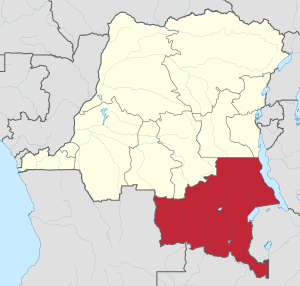Katanga Province facts for kids
Quick facts for kids
Katanga Province
Province du Katanga
|
|
|---|---|
|
Former province of the
Democratic Republic of the Congo |
|
 |
|
| Country | |
| Established | 1966 |
| Dissolved | 2015 |
| Capital | Lubumbashi |
| Largest city | Lubumbashi |
| Area | |
| • Total | 496,871 km2 (191,843 sq mi) |
| Population
(2010 est.)
|
|
| • Total | 5,608,683 |
| • Density | 11.288006/km2 (29.23580/sq mi) |
| Demonym(s) | Katangese |
| Official language | French |
| National languages spoken | Swahili |
Katanga Province was a large area in the southern part of the Democratic Republic of Congo. It was like a big state or region within the country. Katanga was known for its mountains, which held many valuable ores. Ores are rocks or minerals from which metals can be taken out. One of the most important minerals found there was cobalt, and Katanga had a lot of it – most of the world's supply!
Katanga Province existed as a single province from 1966 until 2015. After 2015, it was divided into four smaller provinces. This change was part of a plan to make the country's government work better.
Contents
Where Was Katanga?
Katanga Province was located in the southeastern part of the Democratic Republic of the Congo. It shared borders with several other countries, including Angola and Zambia. The capital city of Katanga was Lubumbashi, which was also its largest city. Lubumbashi was an important center for mining and trade in the region.
The province was very large, covering an area of about 496,871 square kilometers. This is roughly the size of Spain! Because of its size, Katanga had different types of landscapes, from mountains to plains.
Rich Resources: Ores and Minerals
Katanga was famous for its rich natural resources, especially its minerals. The land was full of valuable ores that were dug out of mines. These minerals were important for many industries around the world.
Some of the key minerals found in Katanga included:
- Copper: This metal is used in electrical wires, pipes, and many other products.
- Cobalt: Katanga was a major source of cobalt. This metal is very important today for making batteries, especially for electric cars and mobile phones.
- Zinc: Used to protect other metals from rust and in batteries.
- Uranium: A special mineral used for nuclear energy.
The mining of these minerals created many jobs and was a big part of the economy in Katanga. People from all over the world were interested in the valuable resources found there.
The Story of Uranium
One of the most significant minerals found in Katanga was uranium. The Shinkolobwe mine in Katanga was a very important source of this mineral. Uranium is a special element that can be used to create a lot of energy. During the 1940s, uranium from the Shinkolobwe mine was used in important scientific projects that explored nuclear energy. This energy can be used for things like generating electricity in power plants.
Life in Katanga
Life in Katanga, especially in its capital Lubumbashi, was influenced by the mining industry. Many people worked in the mines or in businesses that supported the mining operations. The province was also home to many different ethnic groups, and Swahili was one of the main languages spoken, alongside the official language, French.
The landscape of Katanga included rolling hills and vast plains, with some areas having dense forests. The climate was generally tropical, with wet and dry seasons.
The End of a Province
In 2015, Katanga Province was divided into four new provinces. This was part of a larger plan by the government of the Democratic Republic of Congo to create more provinces across the country. The idea was to bring government services closer to the people and to help develop different regions more effectively.
The four new provinces that were created from the former Katanga Province are:
Even though Katanga Province no longer exists as a single administrative unit, its history and its rich mineral resources continue to be very important to the Democratic Republic of Congo.
Images for kids
-
Malachite specimen, showing its natural form and a polished side. Mines near Kolwezi in Katanga provide much of the world's malachite.
-
Another malachite specimen from Katanga, on display at the Royal Ontario Museum.
-
The building where the provincial assembly of Katanga used to meet in Lubumbashi.
See also
 In Spanish: Provincia de Katanga para niños
In Spanish: Provincia de Katanga para niños






